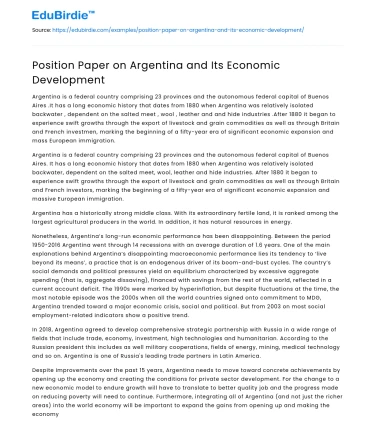Argentina is a federal country comprising 23 provinces and the autonomous federal capital of Buenos Aires .It has a long economic history that dates from 1880 when Argentina was relatively isolated backwater , dependent on the salted meet , wool , leather and and hide industries .After 1880 it began to experience swift growths through the export of livestock and grain commodities as well as through Britain and French investmen, marking the beginning of a fifty-year era of significant economic expansion and mass European immigration.
Argentina is a federal country comprising 23 provinces and the autonomous federal capital of Buenos Aires. It has a long economic history that dates from 1880 when Argentina was relatively isolated backwater, dependent on the salted meet, wool, leather and hide industries. After 1880 it began to experience swift growths through the export of livestock and grain commodities as well as through Britain and French investors, marking the beginning of a fifty-year era of significant economic expansion and massive European immigration.
Save your time!
We can take care of your essay
- Proper editing and formatting
- Free revision, title page, and bibliography
- Flexible prices and money-back guarantee
Argentina has a historically strong middle class. With its extraordinary fertile land, it is ranked among the largest agricultural producers in the world. In addition, it has natural resources in energy.
Nonetheless, Argentina’s long-run economic performance has been disappointing. Between the period 1950-2016 Argentina went through 14 recessions with an average duration of 1.6 years. One of the main explanations behind Argentina’s disappointing macroeconomic performance lies its tendency to ‘live beyond its means’, a practice that is an endogenous driver of its boom-and-bust cycles. The country’s social demands and political pressures yield an equilibrium characterized by excessive aggregate spending (that is, aggregate dissaving), financed with savings from the rest of the world, reflected in a current account deficit. The 1990s were marked by hyperinflation, but despite fluctuations at the time, the most notable episode was the 2000s when all the world countries signed onto commitment to MDG, Argentina trended toward a major economic crisis, social and political. But from 2003 on most social employment-related indicators show a positive trend.
In 2018, Argentina agreed to develop comprehensive strategic partnership with Russia in a wide range of fields that include trade, economy, investment, high technologies and humanitarian. According to the Russian president this includes as well military cooperations, fields of energy, mining, medical technology and so on. Argentina is one of Russia's leading trade partners in Latin America.
Despite improvements over the past 15 years, Argentina needs to move toward concrete achievements by opening up the economy and creating the conditions for private sector development. For the change to a new economic model to endure growth will have to translate to better quality job and the progress made on reducing poverty will need to continue. Furthermore, integrating all of Argentina (and not just the richer areas) into the world economy will be important to expand the gains from opening up and making the economy more productive. Finally, protecting the environment and harnessing the value of nature for development will be essential to ensure the sustainability of economic growth.






 Stuck on your essay?
Stuck on your essay?

